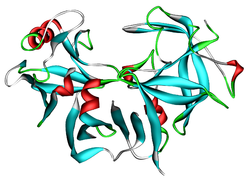Renin
| Renin | ||
|---|---|---|

|
||
| Ribbon model of the renin dimer according to PDB 2REN | ||
| Properties of human protein | ||
| Mass / length primary structure | 340 amino acids | |
| Cofactor | ATP6AP2 | |
| Precursor | Prorenin, 383 AS | |
| Isoforms | 2 | |
| Identifier | ||
| Gene names | REN HNFJ2 | |
| External IDs | ||
| Enzyme classification | ||
| EC, category | 3.4.23.15 , endopeptidase | |
| MEROPS | A01.007 | |
| Response type | hydrolysis | |
| Substrate | Leucine binding in angiotensinogen | |
| Products | Angiotensin I. | |
| Occurrence | ||
| Parent taxon | Vertebrates | |
| Orthologue | ||
| human | House mouse | |
| Entrez | 5972 | 19701 |
| Ensemble | ENSG00000143839 | ENSMUSG00000070645 |
| UniProt | P00797 | P06281 |
| Refseq (mRNA) | NM_000537 | NM_031192 |
| Refseq (protein) | NP_000528 | NP_112469 |
| Gene locus | Chr 1: 204.15 - 204.17 Mb | Chr 1: 133.35 - 133.36 Mb |
| PubMed search | 5972 |
19701
|
Renin (from Latin ren , dt., Kidney ') is a hormone-like enzyme (endopeptidase), which in the kidneys of vertebrates in the cells of the juxtaglomerular apparatus is formed (JGA). In the JGA the epithelial cells of the distal tubule touch the afferent arteriole (see also structure of the nephron ). Renin is released either when the blood pressure is low in the afferent arteriole or when the sodium concentration is low in the distal tubule. In addition, catecholamines can lead to increased renin release via β-adrenoceptors . All three key stimuli for renin secretion indicate a drop in blood pressure. The JGA is one of the most important sensors for a drop in blood pressure. Renin stimulates a very efficient system for increasing blood pressure: the Renin-Angiotensin-Aldosterone System (RAAS).
It was discovered by Robert Tigerstedt in 1898 .
construction
Renin is made up of two lobes; the gap between the two lobes contains the active center with two catalytic aspartate groups. The inactive precursor prorenin is equipped with an additional N-terminal propeptide with a length of 43 amino acids, which covers the enzymatically active cleft in the molecule. The molar mass of prorenin is approx. 5 kDa higher than that of renin. Prorenin circulates in the plasma at a concentration that is up to 100 times higher than the concentration of renin.
effect
Prorenin is activated by proteolysis, low temperatures or an acidic environment. In vivo activation takes place by kallikrein or other serine proteases . In addition, there is a storage form of the active renin in the juxtaglomerular apparatus of the kidney , which can be released acutely. Chronic stimulation, on the other hand, mainly leads to the release of prorenin.
Renin sets off a sequence of reactions ( cascade ) that looks like this:
As protease renin converts the previously inactive angiotensinogen from the liver into angiotensin I to. This in turn is of the especially in the lung formed Angiotensin Converting Enzyme (ACE) Angiotensin II is converted, which has a negative feedback manner on renin formation, thus preventing renin overproduction. Angiotensin II is very vasoconstricting and, in the last step, also promotes the release of aldosterone and antidiuretic hormone (ADH), which is also known as adiuretin or vasopressin.
In kidney diseases that reduce blood flow ( stenoses , arteriosclerosis , often age-related), too much renin is formed ( hyperreninism ), which manifests itself in an increase in blood pressure , arterial hypertension .
Some antihypertensive drugs act on the renin-angiotensin-aldosterone system . These include above all ACE inhibitors and AT1 antagonists . The relatively new group of renin inhibitors has so far been of minor clinical importance.
In addition to the (humoral) renin-angiotensin system dissolved in the plasma, there is a tissue-based renin-angiotensin system in the kidneys. Mesangial cells of the kidney express a receptor for (pro) renin on their surface . Prorenin binds to this receptor with the propeptide, thereby opening the catalytic cleft. Renin is activated by binding to the receptor without the need for enzymatic cleavage of the propeptide. By blocking the (pro) renin receptor, a regression of the diabetic kidney damage could be achieved in animal experiments .
Web links
swell
- ↑ Entry at OMA
- ^ AH Jan Danser, Jaap Deinum: Renin, Prorenin and the Putative (Pro) renin Receptor. Hypertension 46: 1069-1076.
- ↑ H. Takahashi et al .: Regression of Nephropathy Developed in Diabetes by (Pro) renin Receptor Blockade. In: J Am Soc Nephrol . 2007 18: 2054-2061.